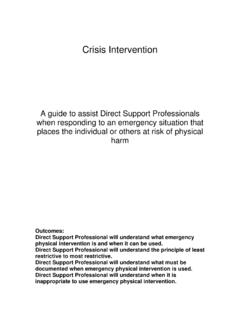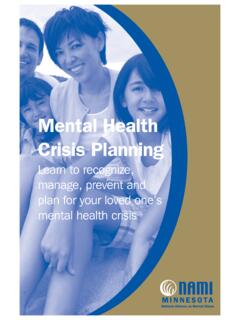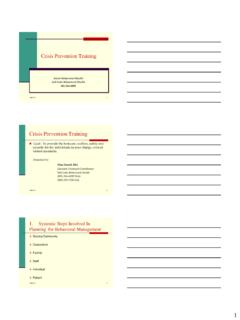Transcription of Suicide Prevention, Assessment, and Intervention
1 Suicide Prevention, Assessment, and Intervention Presented by Dawn Goldstein, PhD, PMHNP-BC. May, 7, 2020. Objectives Analyze issues related to Suicide risk Describe the role of the nurse or clinician in assessment, management and referral of the suicidal client Discuss appropriate follow-up for long-term management of the suicidal client MEDPAGE TODAY, 2019. Question If you ask a person about his or her suicidal intentions, you will encourage the person to kill themselves. A. True B. False Case Study A community nurse in a large urban center is asked to see Julian. Julian, a 22-year-old man who identifies as Anishinabe, has entered the clinic and requested to see a physician or nurse.
2 He shows minimal emotion ( flat effect), and seems preoccupied and restless. He shares that he is experiencing suicidal thoughts What is the first thing the nurse should do? A. Ask what brings him to the clinic and attempts to understand what she might do to make him comfortable. B. Completes a history that includes questions about his family and community C. Reflect on her own assumptions, beliefs and values that impact how she responds to Julian. D. Asks him about his beliefs about health, illness, and healing. What is this patient's risk level? A. Low Acute Risk B. Intermediate (moderate) Acute Risk C. High Acute Risk D. Unable to determine Definitions Suicide is defined as death caused by self- directed injurious behavior with intent to die as a result of the behavior.
3 A Suicide attempt is a non-fatal, self-directed, potentially injurious behavior with intent to die as a result of the behavior. A Suicide attempt might not result in injury. Suicidal ideation refers to thinking about, considering, or planning Suicide . Suicide in the United States Suicide was the tenth leading cause of death overall in the United States, claiming the lives of over 47,000 people. Suicide was the second leading cause of death among individuals between the ages of 10 and 34. There were more than twice as many suicides (47,173) in the as homicides (19,510). On average, 123 suicides/day (CDC, 2017). In Primary Care: At least 2/3's of Suicide deaths occur within about 30 days of a medical contact, be that an emergency department (ED), a primary care practice, or a mental health professional.
4 83% of individuals who died by Suicide had a health care visit in the year prior and contact with a PCP was the most common type of visit (64%). Comorbidity Adults with a mental illness are at increased risk for attempting and completing Suicide More than 70% of adults who have attempted Suicide have an anxiety disorder Adults who has a Substance Use Disorder (SUD) or Major Depressive Disorder (MDD). episode within the past year have higher rates of suicidal thoughts, plans, and attempts Epidemiology High Risk Populations Gender Age Race/Ethnicity LGBTQ. Mental Illness Veterans CDC, 2017. Other Vulnerable Populations: Child or Adolescent Acute embarrassment or loss that seems major to the individual Strong desire to die with a definite, lethal method in mind Relatively older youth Prior attempts Male 4x greater than females Concurrent major psychopathology Substance abuse Overall poor coping style High level of environmental stressors Poor or impaired communications with adults Inconsistent and chaotic family support Veteran's and Suicide 6000 Veteran Suicides yearly Veterans are at a x greater risk of Suicide 69% involve firearms Veterans recently using VHA services have a higher rate than those who did not utilize VHA.
5 Services Michigan's Suicide Rate Spiked 33% from 1999 to 2016. 2nd leading cause of death for ages 15-24. Higher rates among: Young people Rural residents Veterans Famers Opioid use disorders link to Suicide and unintentional Suicide Effective Prevention Strategies Train staff to recognize and respond to warning signs Screen for and manage depression Screen all patients for Suicide risk Educate patients about warning signs for Suicide Safety plan Promote connectedness Teach coping and problem-solving skills Assessing Suicide Risk Strongest Warning Signs take immediate action Threatening to hurt or kill one's self Talking of wanting to hurt or kill one's self Looking for the means to kill one's self access to firearms, pills, etc.
6 Talking about feeling hopeless Protective Factors May mitigate risk in a person with moderate to low risk Sense of responsibility to family Life satisfaction Social support; sense of belonging Coping skills Problem-solving skills Strong therapeutic relationship with a trusted provider Religious faith Protective Factors Quality care for mental, Continuous and quality physical and substance medical and mental use disorders health relationships Quality family and Skills in problem solving, community support conflict resolution and nonviolent skills to handle Cultural and religious disputes beliefs that discourage Suicide New Research on Suicide Prevention Implementing Universal Suicide Risk In Medical Settings Tier 3: Full Safety Evaluation by a Licensed Mental Health Professional Tier 2.
7 Administer a Brief Suicide Safety Assessment Tier 1: Initial Suicide Screening Brahmbhatt K et al. 2018. Screening Universal screening: use of a validated screening tool to identify individuals at risk Patient Health Questionnaire-2. Initial screening Patient Health Questionnaire-9. Item #9 to identify Suicide risk Over the past two weeks, how often have you been bothered by thoughts that you would be better off dead or of hurting yourself in some way? . Possible Responses: Not at all, Several days, More than half the days, or Nearly every day . Columbia Suicide Severity Rating Scale Specialized tool ( ). Question Once a person is seriously considering Suicide , there is nothing you can do.
8 A. True B. False Question Suicide happens without warning. A. True B. False Clinical Evaluation Evaluating a client for Suicide risk does not predict its occurrence; rather it is a judgment of current likelihood of an attempt Discussing plans or ideas may relieve client of anxiety and guilt and establish a safe environment for full assessment of the concern Suicide Inquiry Suicide is very personal: Use nonjudgmental, non-condescending, matter-of-fact approach empathic listening Begin interview with general questions and move to specific. Look for a + response to question 9 on PHQ-9 . inquire further Nonjudgmental Listening Pay close attention to: Your attitudes and how they are conveyed Acceptance, genuineness, and empathy Effective communication skills, both verbal and nonverbal Ask questions to show you genuinely care.
9 Listen to what is being said and how they say it Show that you are listening Avoid giving unhelpful advice Considerations Suicidal people often experience tremendous ambivalence - appeal to the part that wants to live: Offer immediate emotional support Strengthen protective factors Value their experiences Thoughts of Suicide Uncover suicidal thinking Sometimes, people in your situation (describe). lose hope; I'm wondering if you may have lost hope too? . Have you ever thought about killing yourself? . Have you ever thought things would be better if you were dead? . This must be a hard time for you; what do you think about when you are feeling down? . Are you thinking of killing yourself?
10 If so then ask about a plan Prior Attempts A history of a prior attempt is the strongest predictor of future suicidal behavior Have you ever tried to kill yourself or attempt Suicide ? . Questions to Assess Suicidal Ideation When did you begin having suicidal thoughts? . How often do you have thoughts of Suicide ? . How long do they last? How strong are these thoughts? . What do you do when you have suicidal thoughts? . Plan Ask whether the patient has a plan and if so, get specifics Do you have a plan or have you been planning to end your life? If so, how would you do Where would you do it? . Do you have the means (pills, weapon, rope) that you would use? Where is it right now?











